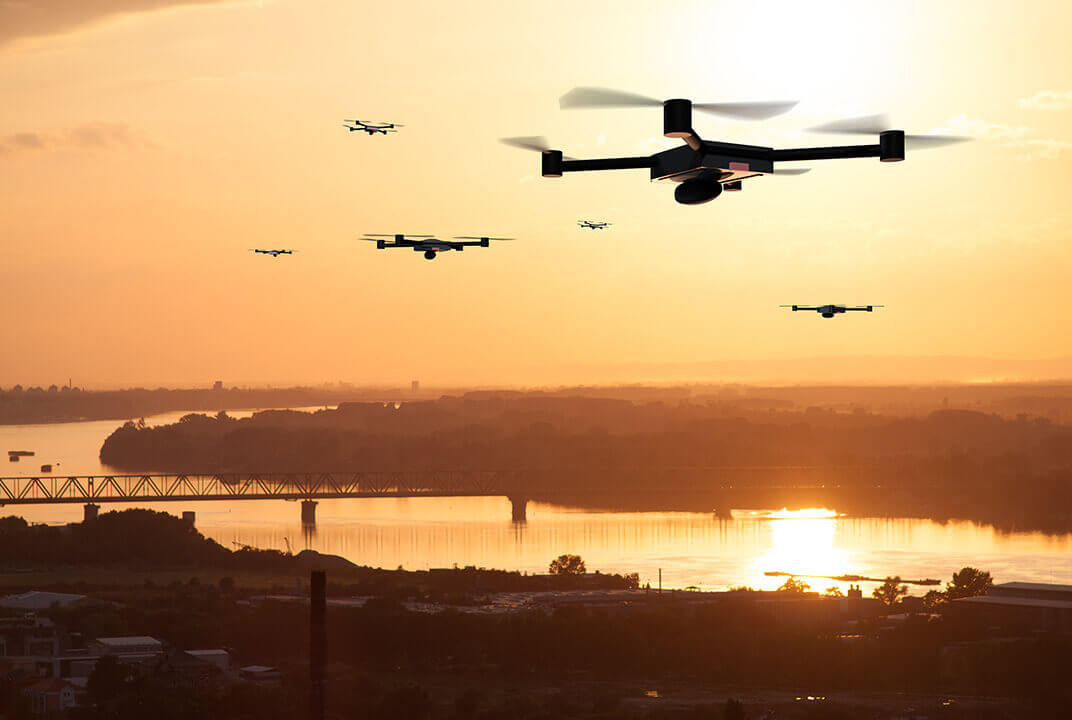Viasat’s New UAV Terminal Takes Flight In Powerline Inspection Demonstration
Aviation
CARLSBAD, Calif., 28 February, 2024 – Viasat, a global leader in satellite communications, has successfully demonstrated the capabilities of its VelarisTM connectivity solution for Uncrewed Aerial Vehicles (UAVs), following a recent power utilities assessment using a small, lightweight terminal developed by its partner, UAV connectivity platform provider, Gotonomi.
Powerlines are notoriously difficult to assess due to their installations, which span large distances in remote locations and include pylon heights ranging from 80 to 200ft. UAVs offer several benefits in comparison to traditional monitoring and inspection tools, such as faster arrival at a scene and unique vantage points from the sky. The addition of satcom technology simplifies the required communications infrastructure and allows a UAV to be operated remotely from a command post, with the ability to stream more extensive data and insights in real-time.
The long-range demonstration, led by ARA Robotics, involved two ARA-405 UAVs, state-of-the-art sensors, and beyond line-of-sight (BVLOS) operations – controlled from a distance of 11 kilometres. The first drone was used as a relay station for Industrial, Scientific, and Medical (ISM) radio for Command and Control (C2) and video, and the second was used as the primary drone for BVLOS operations carrying the video camera, sensors and Satcom payload. This project was conducted in collaboration with the National Research Council of Canada, which has unique expertise and facilities dedicated to research and development in the field of advanced air mobility. This project was made possible with funding from the Innovative Solutions Canada program.
The ARA-405 is equipped with the Gotonomi Velaris SATCOM module - a small, lightweight (300g / 0.6 lbs) unit - providing a secondary command and control link. This redundancy allows the vehicle to choose between SATCOM or line of sight ISM band radio frequency, in the event that one of the two links became degraded, ensuring reliability and resilience of the communications network and thus keeping the operator in constant control of the UAV.
The demonstration took place at the UAS Centre of Excellence (Centre d’excellence sur les drones – CED) in Alma, Quebec, Canada – a dedicated UAV test environment that operates in coordination with Alma airport air traffic control, given its location inside controlled airspace. The results will influence how future solutions can assess power utility infrastructure in remote locations, including the capture of high-definition video and sensor data for inspection services.
Guillaume Charland-Arcand, Chief Technology Officer & Co-founder of ARA Robotics, said: Viasat and Gotonomi were instrumental in providing the Velaris satcom module, a product that had the perfect size weight and power (SWaP) characteristics for the ARA-405. The integration was easy and straightforward, and we received excellent technical support when it was required. The performances of the module were validated in flight and matched their specification. Multiple times during the flights, the communication system switched seamlessly to the Viasat network which allowed us to keep command and control over the UAVs. Needless to say, without this product, the long-range demonstration would not have taken place.
Anthony Spouncer, Senior Director of Advanced Air Mobility at Viasat commented: “We were delighted to support the flight demonstrations and validate the reliability of our satcom in action. The new Velaris terminal provided command and control connectivity at multiple points during the flights when the primary 2.4Ghz ISM communication link was disrupted, and operations reverted to the onboard satcom for the system’s communication needs. Demonstrations such as this highlight the capabilities satcom brings to beyond line-of-sight operations in rural environments, and we look forward to working with partners on similar projects in the future."
Roderick Van Den Bergh, Operations Manager at Gotonomi said: “We are excited to see Gotonomi’s platform enabling BVLOS operations for drone operators. We think this is a great demonstration of how our technology can facilitate the ecosystem to develop new capabilities including command and control for safety, telemetry, data services, voice and video streaming.”
An official case study of this flight has been released by ARA Robotics and can be downloaded here.
Further information
Notes
The determination of the overall risk score of the operation in the form of the Specific Assurance and Integrity Level (SAIL) was carried out as described in JARUS SORA Section 2.5.1. according to AC-903-001 section 8.0. Based on the applicable GRC & ARC, the SAIL was determined as level II for the VLOS operations and level III for the BVLOS operations.
About ARA
Based in the city of Montréal, ARA Robotics is a Canadian company that manufactures drones and provides innovative robotic aircraft solutions. These drone-related solutions automate and streamline their clients’ daily tasks, redefining operational efficiency like never before. Their comprehensive suite of ready-made solutions, including surveying and reconnaissance, are used globally by customers in industries such as mining, defence and aerospace. All their drones are supported by their proprietary commercial flight controller and their ground control station software. Learn more at https://www.ara-uas.com or follow them on LinkedIn and Facebook.
About Gotonomi
Gotonomi’s mission is to enable always on-connectivity for autonomous and remotely piloted vehicles, making safe and scalable beyond visual line of sight operations a reality. We have a vision to provide a platform for the development of UAV services for safe autonomous operation on land sea and air. Our disruptive miniaturised communication system designed by TTP plc enables satellite and cellular connectivity to smaller and lighter-weight UAVs. Connecting to the Viasat Velaris network, our technology enables beyond visual line of sight operations by enabling command and control, telemetry, data services such as video streaming, voice relay and all services required for air traffic management.
About Viasat
Viasat is a global communications company that believes everyone and everything in the world can be connected. With offices in 24 countries around the world, our mission shapes how consumers, businesses, governments and militaries around the world communicate and connect. Viasat is developing the ultimate global communications network to power high-quality, reliable, secure, affordable, fast connections to positively impact people's lives anywhere they are—on the ground, in the air or at sea, while building a sustainable future in space. In May 2023, Viasat completed its acquisition of Inmarsat, combining the teams, technologies and resources of the two companies to create a new global communications partner. Learn more at www.viasat.com, the Viasat News Room or follow us on Facebook, Instagram, LinkedIn, X or YouTube.

